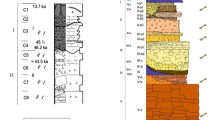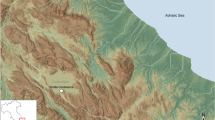Abstract
In recent years, various methods have been developed to infer from mammal tooth wear patterns the abrasiveness of the food they consumed, which reflects the amount of dust in their habitat and thus the environment they inhabit. One of these methods is mesowear analysis, which is applied particularly to fossils in order to reconstruct palaeoenvironment, but increasingly also to species protection management of recent animals. In numerous studies this method has been applied to the teeth of large herbivorous mammals. Despite the well-known importance of small mammal fossils, which occur in great numbers in countless Cenozoic sites giving a large sample size and provide significant palaeontological data, mesowear analysis has not yet been applied to this group. In the present work, teeth of various hare and mice species (Leporinae and Murinae) are subjected to a mesowear analysis for the first time. We aim to test the applicability of the method in these groups. Our results clearly indicate that significant mesowear signals are evident in Leporinae as well as Murinae, reflecting known habitat conditions of the species. Furthermore, problems and limitations of the application of the mesowear methods on small mammal teeth are discussed.
Similar content being viewed by others
References
Averianov, A.O., Niethammer, J., Pegel, M., 2003. Lepus europaeus – Feldhase. In: Krapp, F. (Ed.), Handbuch der Säugetiere Europas. Band 3/II: Hasentiere. Lagomorpha. AULA-Verlag, Wiesbaden, pp. 35–104.
Charles, C., Jaeger, J.J., Michaux, J., Viriot, L., 2007. Dental microwear in relation to changes in the direction of mastication during the evolution of Myodonta (Rodentia, Mammalia). Naturwissenschaften 94, 71–75.
Croft, D.A., Weinstein, D., 2008. The first application of the mesowear method to endemic South American ungulates (Notoungulata). Palaeogeogr. Palaeoclimatol. Palaeoecol. 269, 103–114.
DeMiguel, D., Azanza, B., Morales, J., 2011. Paleoenvironments and paleoclimate of the Middle Miocene of central Spain: a reconstruction from dental wear of ruminants. Palaeogeogr. Palaeoclimatol. Palaeoecol. 302, 452–463.
Fortelius, M., Solounias, N., 2000. Functional characterization of ungulate molars using the abrasion-attrition wear gradient: a new method for reconstructing paleodiets. Am. Mus. Novit. 3301, 1–36.
Fraser, D., Theodor, J.M., 2010. The use of gross dental wear in dietary studies of extinct lagomorphs.J. Paleontol. 84, 720–729.
Fraser, D., Theodor, J.M., 2013. Ungulate diets reveal patterns of grassland evolution in North America. Palaeogeogr. Palaeoclimatol. Palaeoecol. 369, 409–421.
Gomes-Rodrigues, H., Merceron, G., Viriot, L, 2009. Dental microwear patterns of extant and extinct Muridae (Rodentia, Mammalia): ecological implications. Naturwissenschaften 96, 537–542.
Granjon, L., Bekele, A., Ducroz, J.-F., 2013. Arvicanthis niloticus – Nile grass rat (unstriped grass rat). In: Happold, D.C.D. (Ed.), Mammals of Africa, vol. III. Bloomsbury Trade, pp. 387–388.
Happold, D.C.D., 2013. Lepus capensis – cape hare. In: Happold, D.C.D. (Ed.), Mammals of Africa, vol. III. Bloomsbury Trade, pp. 699–701.
Hillson, S., 2005. Teeth. Cambridge Manuals in Archaeology. Cambridge University Press, Cambridge.
Hoffmann, J.M., (Ph.D. Thesis) 2006. Using stable carbonate isotope, microwear, and mesowear analysis to determine the paleodiets of Neogene ungulates and the presence of C4 or C3 grasses in Northern and Central Florida. University of Florida.
Hofmann, R.R., 1973. The Ruminant Stomach. Stomach Structure and Feeding Habits of East African Game Ruminants. East African Monographs in Biology, vol. 2. East African Literature Bureau.
Hopley, P.J., Latham, A.G., Marshall, J.D., 2006. Palaeoenvironments and paeodiets of mid-Pliocene micromammals from Makapansgat Limeworks, South Africa: a stable isotope and dental microwear approach. Palaeogeogr. Palaeoclimatol. Palaeoecol. 233, 235–251.
Jardine, P.E., Janis, C.M., Sahney, S., Benton, M.J., 2012. Grit not grass: concordant patterns of early origin of hypsodonty in Great Plains ungulates and Glires. Palaeogeogr. Palaeoclimatol. Palaeoecol. 365–366, 1–10.
Jenrich, J., Löhr, P.-W., Müller, F., 2010. Kleinsäuger. Körper- und Schädelmerkmale, Ökologie. Beiträge zur Naturkunde in Osthessen, vol. 47., pp. 1–240.
Kahlke, R.D., Kaiser, T.M., 2011. Generalism as a subsistence strategy: advantages and limitations of the highly flexible feeding traits of Pleistocene Stephanorhinus hundsheimensis (Rhinocerotidae, Mammalia). Quat. Sci. Rev. 30, 2250–2261.
Kaiser, T.M., Fortelius, M., 2003. Differential mesowear in occluding upper and lower molars: opening mesowear analysis for lower molars and premolars in hypsodont horses. J. Morphol. 258, 67–83.
Koenigswald, W., Anders, U., Engels, S., Schultz, J., Ruf, I., 2010. Tooth morphology in fossil and extant Lagomorpha (Mammalia) reflects different mastication patterns. J. Mamm. Evol. 17, 275–299.
Louys, J., Meloro, C., Elton, S., Ditchfield, P., Bishop, L.C., 2011. Mesowear as a means of determining diets in African antelopes. J. Archaeol. Sci. 38, 1485–1495.
Massey, F.P., Hartley, S.E., 2006. Experimental demonstration of the antiherbivore effects of silica in grasses: impacts on foliage digestibility and vole growth rates. Proc. R. Soc. B: Biol. Sci. 273, 2299–2304.
Massey, F.P., Ennos, A.R., Hartley, S.E., 2007. Grasses and the resource availability hypothesis: the importance of silica-based defences. J. Ecol. 95, 414–424.
Monadjem, A., 2013. Mus minutoides – tiny pigmy mouse. In: Happold, D.C.D. (Ed.), Mammals of Africa, vol. III. Bloomsbury Trade, pp. 484–486.
Müller, J., Clauss, M., Codron, D., Schulz, E., Hummel, J., Fortelius, M., Kircher, M., Hatt, J.-M., 2014. Growth and wear of incisor and cheeck teeth in domestic rabbits (Oryctolagus cuniculus) feed diets of different abrasiveness. J. Exp. Zool. A 321A, 283–298.
Nelson, S., Badgley, C., Zakem, E., 2005. Microwear in modern squirrels in relation to diet. Palaeontol. Electron. 8, 14A–15A.
Niethammer, J., 1978. Apodemus flavicollis (Melchior, 1834) – Gelbhalsmaus. In: Niethammer, J., Krapp, F.(Eds.), Handbuch derSäugetiere Europas. Akademische Verlagsgesellschaft, Wiesbaden, pp. 325–336.
Rivals, F., Mihlbachler, M.C., Solounias, N., 2007. Effect of ontogenetic-age distribution in fossil and modern samples on the interpretation of ungulate paleodiets using the mesowear method. J. Vertebr. Paleontol. 27, 763–767.
Sanson, G.D., Kerr, S.A., Gross, K.A., 2007. Do silica phytoliths really wear mammalian teeth?. J. Archaeol. Sci. 34, 526–531.
Schulz, E., Kaiser, T.M., 2007. Feeding strategy of the Urus Bos primigenius BOJANUS, 1827 from the Holocene of Denmark. Cour. Forsch. Senckenberg 259, 155–164.
Schulz, E., Kaiser, T.M., 2013. Historical distribution, habitat requirements and feeding ecology of the genus Equus (Perissodactyla). Mamm. Rev. 43, 111.
Schulz, E., Piotrowski, V., Clauss, M., Mau, M., Merceron, G., Kaiser, T.M., 2013a. Variability in dental microwear is not associated with diet variety but with diet abrasiveness. PLoS ONE 8, e56167.
Schulz, E., Fraas, S., Kaiser, T.M., Cunningham, P.L., Ismail, K., Wronski, T., 2013b. Food preferences and tooth wear in the sand gazelle (Gazella marica). Mamm. Biol. Z. Säugetierk. 78, 55.
Semprebon, G., Janis, C., Solounias, N., 2004a. The diets of the Dromomerycidae (Mammalia: Artiodactyla) and their response to Miocene vegetational change. J. Vertebr. Paleontol. 24, 427.
Semprebon, G.M., Godfrey, L.R., Solounias, N., Sutherland, M.R., Jungers, W.L., 2004b. Can low-magnification stereomicroscopy reveal diet? J. Hum. Evol. 47, 115.
Taylor, L.A., Kaiser, T.M., Schwitzer, C., Müller, D.W.H., Codron, D., Clauss, M., Schulz, E., 2013. Detecting inter-cusp and inter-tooth wear patterns in Rhinocerotids. PLoS ONE 8, e80921.
Thenius, E., 1976. Pleistozäne Säugetiere als Klima-Indikatoren. Archaeol. Austr. Beih. 13, 91.
Thenius, E., 1989. Zähne und Gebiss derSäugetiere. de Gruyter, Berlin, New York. Ungar, P.S., 2010. Mammal Teeth. Origin, Evolution, and Diversity. The John Hopkins University Press, Baltimore.
Vandebroek, G., 1961–1962. The Comparativee Anatomy of the Teeth of Lower and Non Spezialized Mammals, vol. 1–2. PaleisderAcademiën, Brussels.
Winkler, D.E., Kaiser, T.M., 2011. A case study of seasonal, sexual and ontogenetic divergence in the feeding behaviour of the moose (Alces alces LINNÉ, 1758).Verh. Naturwissenschaftl. Ver. Hamb. 46, 331.
Author information
Authors and Affiliations
Corresponding author
Rights and permissions
About this article
Cite this article
Ulbricht, A., Maul, L.C. & Schulz, E. Can mesowear analysis be applied to small mammals? A pilot-study on leporines and murines. Mamm Biol 80, 14–20 (2015). https://doi.org/10.1016/j.mambio.2014.06.004
Received:
Accepted:
Published:
Issue Date:
DOI: https://doi.org/10.1016/j.mambio.2014.06.004




